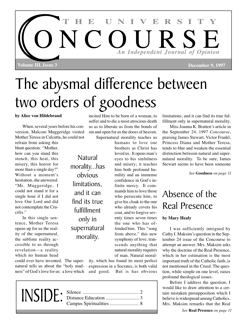Absence of the Real Presence
by Mary Healy
I was sufficiently intrigued by Cathy I. Maksim’s question in the September 24 issue of the Concourse to attempt an answer. Mrs. Maksim asks why the doctrine of the Real Presence, which in her estimation is the most important truth of the Catholic faith, is not mentioned in the Creed. The question, while simple on one level, raises profound theological issues.
Before I address the question, I would like to draw attention to a certain mistaken presupposition which I believe is widespread among Catholics. Mrs. Maksim remarks that the Real Presence is “the true heart of our faith which sets us singularly apart from all our Christian brethren.” But this is to confuse two very different things. What is most important is not at all the same as what distinguishes us from other Christians. The Catechism teaches that the heart of our faith is the mystery of the Trinity (CCC 234), and secondly, that of Jesus Christ, true God and true man (CCC 426). (Of course, this does not mean that other doctrines are optional or less certain, merely that they are organized around a central source.) These are the doctrines we do share with other Christians, which is precisely why Pope John Paul II could teach that what unites us with them is much greater than what divides us.1 The danger of Mrs. Maksim’s hidden premise is that it can do exactly what she wished to avoid: distort the definition of the term “Catholic.” It risks viewing the faith through partisan lenses (i.e. as primarily what is not Protestant) rather than in the form and proportions in which Christ has revealed it. If non-Catholics deny certain doctrines of the faith, such as the Real Presence, the role of the Blessed Virgin, or the papacy, the challenge for us is to uphold them clearly and cogently without causing distortion in the opposite direction by giving them a false status in the hierarchy of truth.
As to why the Real Presence, which undeniably ranks high in the hierarchy of truth, is not mentioned in the Creed, one can answer from several viewpoints.
Historically, the Apostles’ Creed was formed as a clear and simple summary of the faith which could be used in baptismal catechesis. After the great trinitarian and christological debates of the early centuries, when these central mysteries of the faith had reached a stage of clear articulation, a more elaborate creed was formulated in order to guard against the heresies that had arisen. This more detailed version, the Nicene Creed, was promulgated in 381. Since then, although there have been multitudes of heresies, nothing has been added to this venerable Creed, with one exception: the phrase “and the Son” (filioque in Latin) was appended to “the Holy Spirit, who proceeds from the Father” by Pope Benedict VIII in the eleventh century, causing a serious rift with the Church in the East that has remained to this day. If the Catholic Church were to again unilaterally add a phrase to the Creed, it would cause a major ecumenical crisis. Moreover, there is no reason to stop with the Real Presence, but any number of other controverted doctrines, such as original sin or the infallibility of the pope, could be inserted. The result might be edifying, but it would no longer be the ancient symbol which rests on the weighty authority of the Fathers, the early ecumenical councils, and more than 16 centuries of profession by the people of God.
Theologically, why did those early Christians not include something about the Real Presence in their summary of the faith? Part of the answer is that a heresy clearly denying it did not arise until the eleventh century. Moreover, it would never have occurred to the ancients to isolate this doctrine from its context in the liturgy, the whole Eucharistic action in which the Church unites herself with the sacrifice of Christ, commemorates his passion and resurrection, offers thanks to the Father, and partakes of the food of eternal life. It is the Eucharist which, the Church teaches, is “the source and summit of the Christian Life” (CCC 1324). The practice of devotion to the reserved Sacrament outside of Mass began only gradually as Christians came to a deeper faith and understanding of Christ’s presence in the consecrated elements (CCC 1379).
Then what about the Eucharist itself? Its absence from the Creed is certainly no indication that our forefathers did not believe in it. Except for Baptism, none of the sacraments found a place in the Symbol. Perhaps one reason for this is that while the Creed proclaims who God is and what he has done, the sacraments make the divine realities present; they are celebrated rather than professed. Furthermore, teaching on the sacraments was always reserved until after catechumens had already been initiated into the Church through baptism. The Eucharist was seen as a great and holy mystery that had to be kept secret and jealously guarded from unbelievers.
While the doctrine of the Real Presence is not itself the center of the Christian faith, it points to the center. As with other doctrines, the more you meditate on it the more you see its intimate connection with everything else. The Real Presence manifests, for instance, the depth of Christ’s love and humility in allowing himself to be crushed like a grain of wheat and distributed to us. It signifies the continuing presence of the Risen Lord in human history. It expresses the importance of the body in God’s work of salvation. It indicates the objective reality of the sacraments even apart from the holiness of the celebrant or recipient. It points to our transformation into Christ. And the list could go on.
Finally, pastorally, I share intensely in Mrs. Maksim’s concern about the large number of Catholics who no longer believe in the Real Presence. This is a crisis of faith which calls for serious attention, including catechesis, organized times of adoration, and efforts at spiritual renewal. But I do not think that adding a clause to the Creed would help solve the problem. The sad reality is that a line in the Creed recited every week is no guarantee that Catholics will believe a doctrine. Large numbers of Catholics, for instance, do not even know the doctrine of the resurrection of the body, much less believe in it.
It should be noted that the doctrine of the Real Presence does have a place in the Church’s most recent creed, the beautiful Credo of the People of God written by Pope Paul VI. Those who, like Mrs. Maksim, seek to uphold the Church’s teaching on the Eucharist, might find it a helpful tool for dialogue with Protestants.
Thank you, Mrs. Maksim, for your thought-provoking question.
Mary Healy, who graduated from FUS MA theology program in 1988, is currently completing a Licentiate degree at the International Theological Institute in Gaming, Austria.
- Ut Unum Sint, 20. Emphasis mine. ↑


